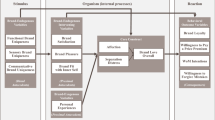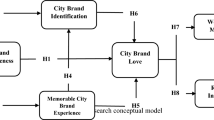Abstract
Brand love is a recent marketing construct, which has been shown to influence important marketing variables such as brand loyalty and word-of-mouth. Although this knowledge is academically interesting, its managerial relevance depends on the identification of actionable antecedents of brand love. This study adds to the understanding of the managerial potential of brand love by proposing and testing two actionable antecedents of brand love: Brand identification and sense of community. The study uses the Partial Least Squares approach to structural equation modelling to analyze data from two survey-based studies. The study tests two conceptual models using data for six different brands. The results show that brand identification and sense of community both have a positive influence on brand love, which in turn has a positive influence on brand loyalty and active engagement. These findings form the basis for a discussion of the use of image extensions and market shielding to strengthen brand identification and sense of community – with the purpose of elaborating and building brand love.


Similar content being viewed by others
References
Ahuvia, A.C. (2005) Beyond the extended self: Loved objects and consumers’ identity narratives. Journal of Consumer Research 32 (1): 171–184.
Whang, Y.-O., Allen, J., Sahoury, N. and Zhang, H. (2004) Falling in love with a product: The structure of a romantic consumer-product relationship. In: B.E. Kahn and M.F. Luce (eds.) Advances in Consumer Research, pp. 320–327.
Fournier, S. (1994) A consumer-brand relationship framework for strategic brand management. Unpublished PhD thesis, University of Florida.
Fournier, S. (1998) Consumers and their brands: Developing relationship theory in consumer research. Journal of Consumer Research 24 (4): 343–373.
Thomson, M., MacInnis, D.J. and Park, W.C. (2005) The ties that bind: Measuring the strength of consumers’ emotional attachments to brands. Journal of Consumer Psychology 15 (1): 77–91.
Carroll, B.A. and Ahuvia, A.C. (2006) Some antecedents and outcomes of brand love. Marketing Letters 17 (2): 79–89.
Roberts, K. (2005) Lovemarks: The Future Beyond Brands, 2nd edn. New York: powerHouse Books.
Pawle, J. and Cooper, P. (2006) Measuring emotion – Lovemarks, the future beyond brands. Journal of Advertising Research 46 (1): 38–48.
Kressman, F., Sirgy, M.J., Herrman, A., Huber, F., Huber, S. and Lee, D.-J. (2006) Direct and indirect effects of self-image congruence on brand loyalty. Journal of Business Research 59 (9): 955–964.
Smit, E., Bronner, F. and Tolboom, M. (2007) Brand relationship quality and its value for personal contact. Journal of Business Research 60 (6): 627–633.
Park, C.W., Jaworski, B.J. and MacInnis, D.J. (1986) Strategic brand concept-image management. Journal of Marketing 50 (4): 135–145.
Belk, R.W. (1988) Possessions and the extended self. Journal of Consumer Research 15 (2): 139–168.
Grunebaum, H. (1997) Thinking about romantic/erotic love. Journal of Marital and Family Therapy 23 (3): 295–307.
Sternberg, R.J. (1987) Liking versus loving: A comparative evaluation of theories. Psychological Bulletin 102 (3): 331–345.
Bagozzi, R.P. and Dholakia, U.M. (2006) Antecedents and purchase consequences of customer participation in small group brand communities. International Journal of Research in Marketing 23 (1): 45–61.
Sirgy, M.J. et al (1997) Assessing the predictive validity of two methods of measuring self-image congruence. Journal of the Academy of Marketing Science 25 (3): 229–241.
Algesheimer, R., Dholakia, U.M. and Herrman, A. (2005) The social influence of brand community: Evidence from European car clubs. Journal of Marketing 69 (3): 19–34.
Brown, T.J., Barry, T.E., Dacin, P.A. and Gunst, R.F. (2005) Spreading the word: Investigating antecedents of consumers’ positive word-of-mouth intentions and behaviors in a retailing context. Journal of the Academy of Marketing Science 33 (2): 123–138.
Ellemers, N., Kortekaas, P. and Ouwerkerk, J.W. (1999) Self-categorisation, commitment to the group and group self-esteem as related but distinct aspects of social identity. European Journal of Social Psychology 29 (2–3): 371–389.
Keller, K.L. (2003) Strategic Brand Management. Building, Measuring, and Managing Brand Equity, 2nd edn. Upper Saddle River, New Jersey: Pearson Education.
Evanschitzky, H., Baumgarth, C., Hubbard, R. and Armstrong, J.S. (2007) Replication research's disturbing trend. Journal of Business Research 60 (4): 411–415.
Chung, C.M.Y. and Darke, P.R. (2006) The consumer as advocate: Self-Relevance, culture, and word-of-mouth. Marketing Letters 17 (4): 269–279.
Jarvis, C.B., Mackenzie, S.B. and Podsakoff, P.M. (2003) A critical review of construct indicators and measurement model misspecification in marketing and consumer research. Journal of Consumer Research 30 (2): 199–218.
Rossiter, J.R. (2002) The C-OAR-SE procedure for scale development in marketing. International Journal of Research in Marketing 19 (4): 305–335.
Bergami, M. and Bagozzi, R.P. (2000) Self-categorization, affective commitment and group self-esteem as distinct aspects of social identity in the organization. The British Journal of Social Psychology 39 (4): 555–577.
Hatfield, E. and Sprecher, S. (1986) Measuring passionate love in intimate relationships. Journal of Adolescence 9 (4): 383–410.
Rubin, Z. (1970) Measurement of romantic love. Journal of Personality and Social Psychology 16 (2): 265–273.
Carstairs, J.R., Myors, B., Shores, E.A. and Fogarty, G. (2006) Influence of language background on tests of cognitive abilities: Australian data. Australian Psychologist 41 (1): 48–54.
Chin, W.W. (2001) Pls-graph User's Guide Version 3.0. Houston, TX: C.T. Bauer College of Business, University of Houston.
Sundaram, S., Schwarz, A., Jones, E. and Chin, W.W. (2007) Technology use on the front line: How information technology enhances individual performance. Journal of the Academy of Marketing Science 35 (1): 101–112.
Cortina, J.M. (1993) What is coefficient alpha? An examination of theory and applications. Journal of Applied Psychology 78 (1): 98–104.
Hulland, J. (1999) Use of partial least squares (PLS) in strategic management research: A review of four recent studies. Strategic Management Journal 20 (2): 195–204.
Fornell, C. and Larcker, D.F. (1981) Evaluating structural equation models with unobservable variables and measurement error. Journal of Marketing Research 18 (1): 39–50.
Chin, W.W. (1998) The partial least squares approach to structural equation modeling. In: G.A. Marcoulides (ed.) Modern Methods for Business Research. Mahwah, NJ: Lawrence Erlbaum, pp. 295–336.
Gefen, D. and Straub, D. (2005) A practical guide to factorial validity using PLS-graph: Tutorial and annotated example. Communications of the Association for Information Systems 16 (16): 91–109.
Baron, R.M. and Kenny, D.A. (1986) The moderator-mediator variable distinction in social psychological research: Conceptual, strategic, and statistical considerations. Journal of Personality and Social Psychology 51 (6): 1173–1182.
Muñiz, A.M. and Schau, H.J. (2005) Religiosity in the abandoned Apple Newton brand community. Journal of Consumer Research 31 (4): 737–747.
McAlexander, J.H., Schouten, J.W. and Koenig, H.F. (2002) Building brand community. Journal of Marketing 66 (1): 38–54.
Newman, B.M. and Newman, P.R. (2006) Development Through Life: A Psychosocial Approach. Massachusetts: Thompson Wadsworth.
Author information
Authors and Affiliations
Corresponding author
Rights and permissions
About this article
Cite this article
Bergkvist, L., Bech-Larsen, T. Two studies of consequences and actionable antecedents of brand love. J Brand Manag 17, 504–518 (2010). https://doi.org/10.1057/bm.2010.6
Received:
Revised:
Published:
Issue Date:
DOI: https://doi.org/10.1057/bm.2010.6




